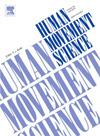Interpersonal coordination in a ball-and-beam paradigm: Transfer of skill from solo action to joint action
IF 1.9
3区 心理学
Q4 NEUROSCIENCES
引用次数: 0
Abstract
Interpersonal coordination is paramount to the success of a joint action. While the pattern formation process of interpersonal coordination is relatively well understood, models like HKB lack an ecological dimension that relates the motor pattern to the environment. We investigated this dimension in a two-step study using the ball-and-beam paradigm. Participants rolled a ball back-and-forth between two targets on a beam, by manipulating the beam inclination either individually or dyadically. In an (earlier reported) first step, 16 participants performed two solo action sessions of the task, allowing us to identify pertinent performance characteristics. Here, those participants were paired into 8 dyads to perform a joint action session, allowing us to assess the solo-to-joint transfer of those characteristics. Over blocks, dyads improved their performance by increasing the ball speed and accuracy. While the relative variability of the beam's inclination angle decreased, the range and the timing of the beam motion remained unchanged. Variables (indirectly) related to ball speed, such as the range and timing of the beam motion, were strongly propagated from solo to joint action, while the variables related to ball accuracy, like the beam variability, were only moderately transferred. Most dyads established an anti-phase mode of coordination, with a significant decrease in phase variability over blocks. We also observed significant asymmetries in the coordination. Dyad members with a better solo-action performance were more likely to lead the interaction. We concluded that interpersonal coordination in the ball-and-beam paradigm emerged from the interaction, while being constrained by the goal of the task.
球梁模式下的人际协调:从单独行动到联合行动的技能转移
人际间的协调对联合行动的成功至关重要。虽然人际协调的模式形成过程相对较好理解,但像HKB这样的模型缺乏将运动模式与环境联系起来的生态维度。我们在使用球-梁范式的两步研究中调查了这个维度。参与者在光束上的两个目标之间来回滚动一个球,通过单独或双方向操纵光束的倾斜度。在(先前报道的)第一步中,16名参与者执行了任务的两个单独动作会话,使我们能够确定相关的性能特征。在这里,这些参与者被分成8对,进行联合动作练习,让我们评估这些特征从个体到关节的转移。在封盖过程中,二人组通过提高球的速度和准确性来提高他们的表现。虽然光束倾角的相对变异性减小,但光束运动的范围和时间不变。与球速度相关的变量(间接),如光束运动的范围和时间,被强烈地从单人动作传播到联合动作,而与球精度相关的变量,如光束可变性,只被适度地传递。大多数二偶体建立了一种反相位协调模式,在块上显著降低了相位变异性。我们还观察到明显的不对称的协调。单人行动表现较好的双人组成员更有可能领导互动。我们的结论是,在球梁范式中,人际协调产生于互动,同时受到任务目标的约束。
本文章由计算机程序翻译,如有差异,请以英文原文为准。
求助全文
约1分钟内获得全文
求助全文
来源期刊

Human Movement Science
医学-神经科学
CiteScore
3.80
自引率
4.80%
发文量
89
审稿时长
42 days
期刊介绍:
Human Movement Science provides a medium for publishing disciplinary and multidisciplinary studies on human movement. It brings together psychological, biomechanical and neurophysiological research on the control, organization and learning of human movement, including the perceptual support of movement. The overarching goal of the journal is to publish articles that help advance theoretical understanding of the control and organization of human movement, as well as changes therein as a function of development, learning and rehabilitation. The nature of the research reported may vary from fundamental theoretical or empirical studies to more applied studies in the fields of, for example, sport, dance and rehabilitation with the proviso that all studies have a distinct theoretical bearing. Also, reviews and meta-studies advancing the understanding of human movement are welcome.
These aims and scope imply that purely descriptive studies are not acceptable, while methodological articles are only acceptable if the methodology in question opens up new vistas in understanding the control and organization of human movement. The same holds for articles on exercise physiology, which in general are not supported, unless they speak to the control and organization of human movement. In general, it is required that the theoretical message of articles published in Human Movement Science is, to a certain extent, innovative and not dismissible as just "more of the same."
 求助内容:
求助内容: 应助结果提醒方式:
应助结果提醒方式:


